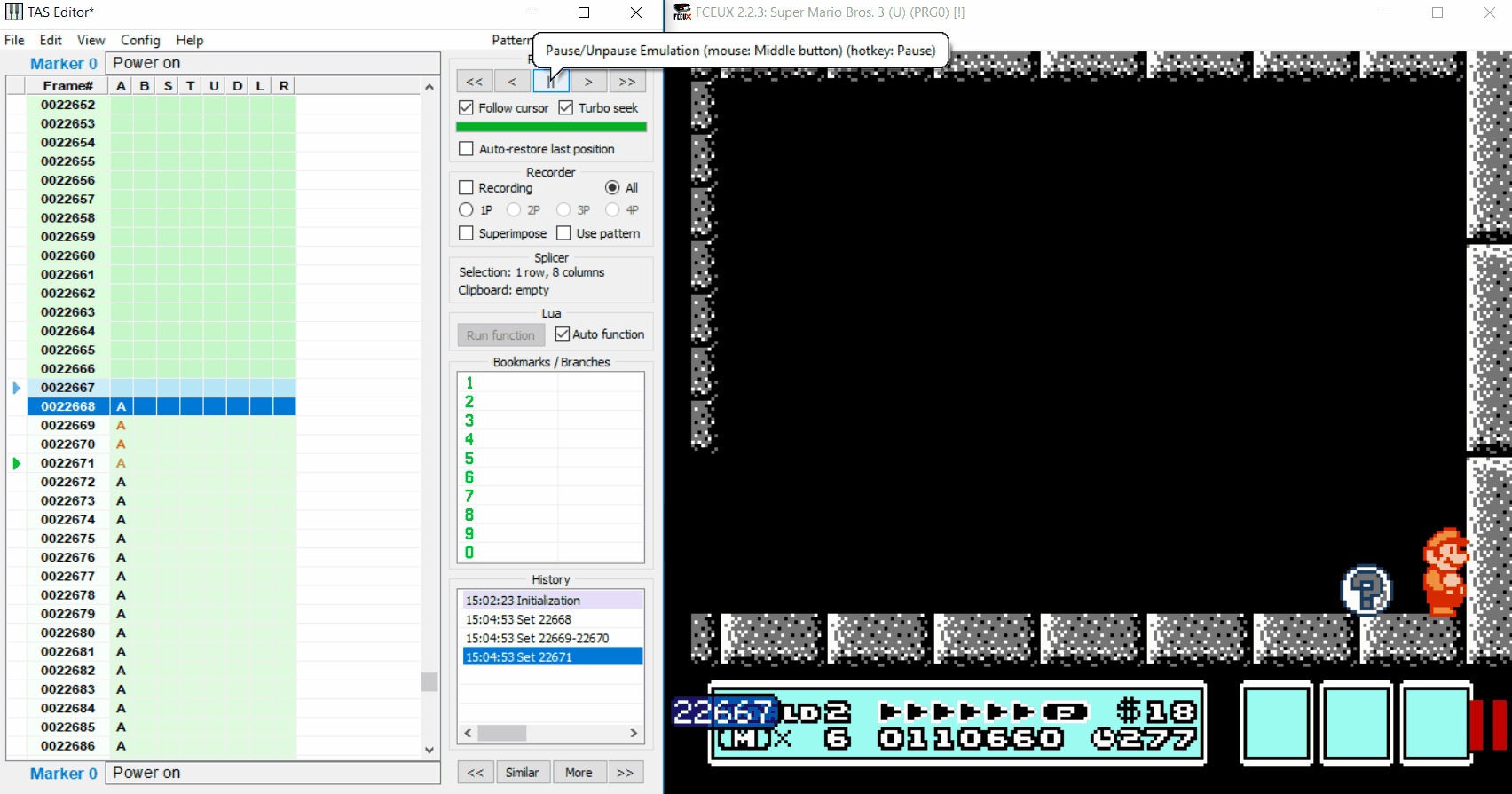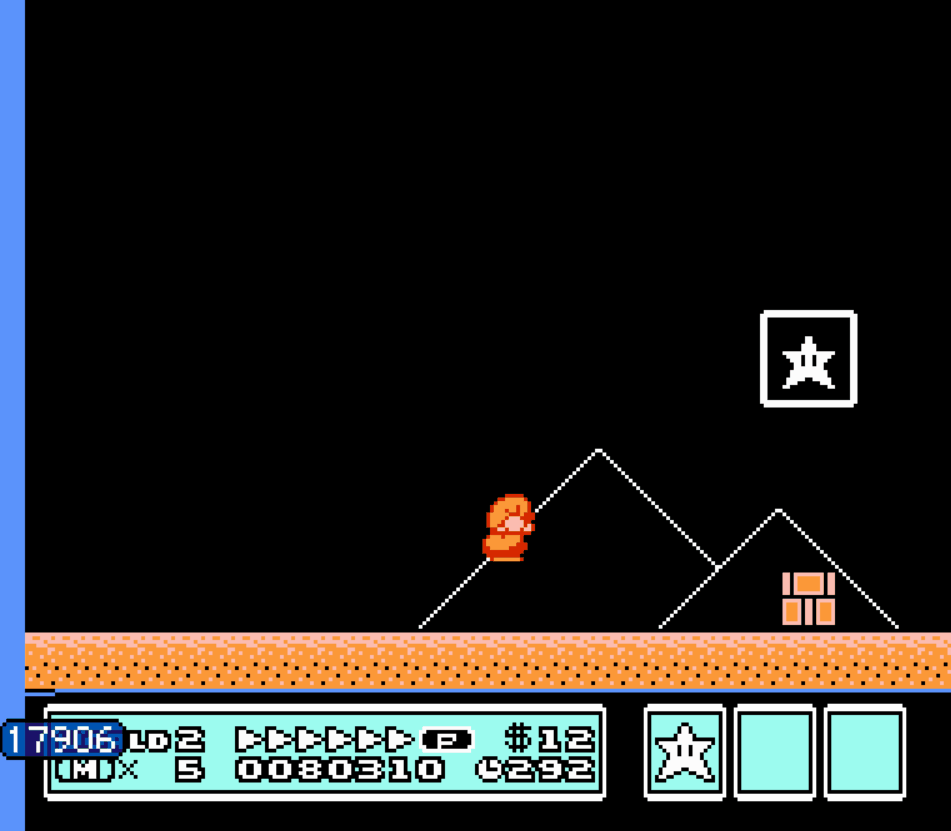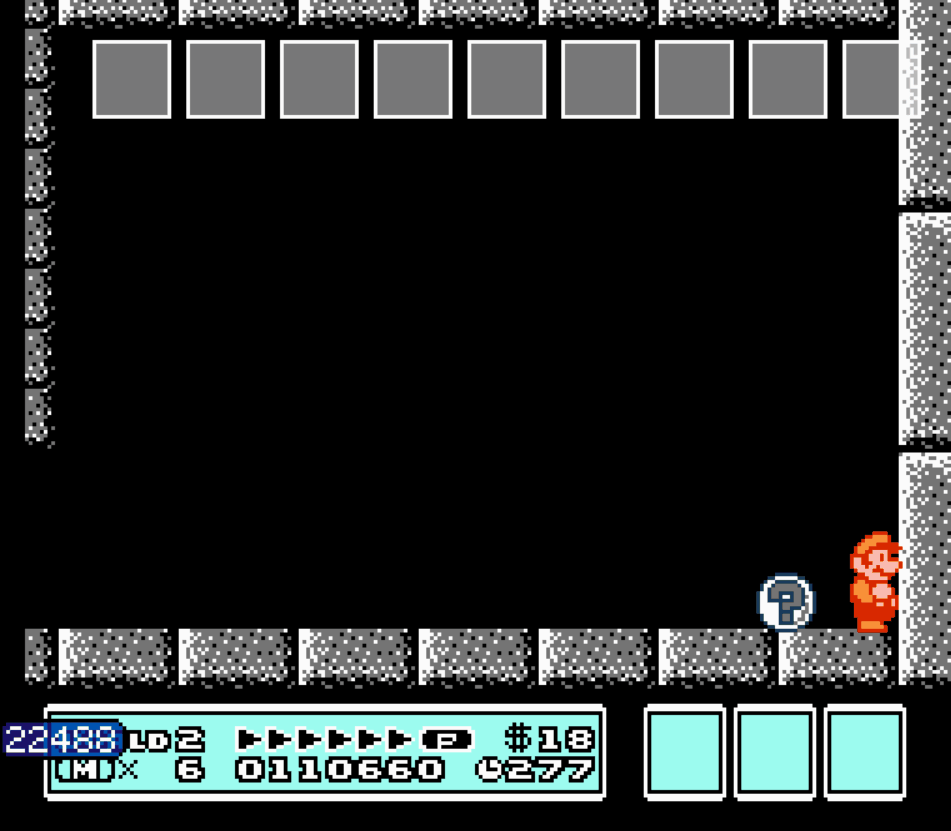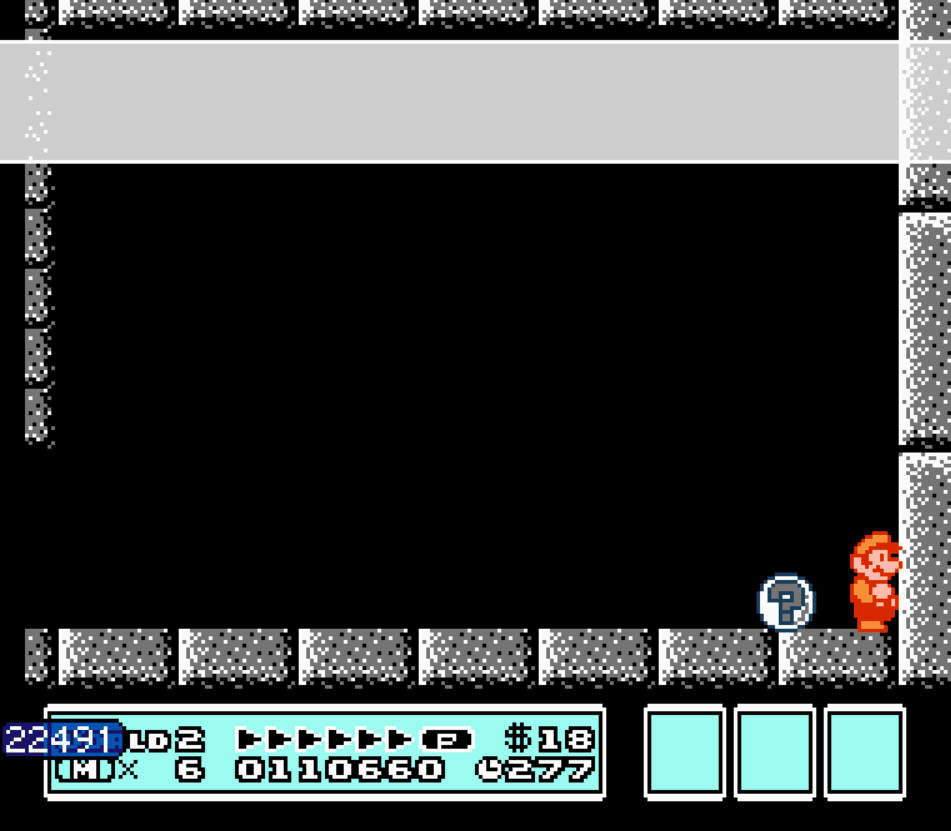Early Hammer Manipulation TAS Creation
This post describes the process of taking the information about known good frames and producing a tool-assisted speedrun from it that achieves a no-death early hammer.
Good Frame Windows
Running my smb3rngchk program causes a bunch of information to spit out showing on which end-of-level frames (see When Does a Level End for when a level ends) the desired hammer brother movements occur for each level. This information is summarized at the top of the output by the following lines:
Max window for 2-1__1: 5
Max window for 2-2__1: 6
adding window of length 2 for level Level 2-f__1: 12256
adding window of length 2 for level Level 2-f__1: 23081
Max window for 2-f__1: 2
Without getting too deep into the weeds about what all of that means, it shows that the program found one or multiple windows of consecutive frames for specific hammer brother movements to occur at the end of 2-1, 2-2, and 2-fort. In the example above, the max amount of frames in a row that it found to give the desired hammer brother movement after 2-1 was 5. It found a window of 5 frames in a row where the Music Box brother and the Hammer brother moved to the correct positions. For 2-2, it found a window of 6 frames in a row. For 2-fort, it found a window of 2 frames.
In actuality, the windows my program looks for after 2-fort are not consecutive, because there’s only one window of 2 consecutive frames in a row where our desired movement occurs, but it occurs too early in the RNG cycle to be used in our TAS. Therefore, our best possible option for a window of frames is one where our desired movement occurs on one frame, does not on the next, and then does again on the third: a [good, bad, good] window. There ends up being two of these such windows, as shown in the program output at frame number 12,256 and 23,081.
Frame number 12,256 occurs roughly 4 minutes (slightly longer than you may have calculated due to lag frames) after reset, which is not long enough to get to World 2 and complete 2-fort. Therefore, the only option is to use frame 23,081, which occurs roughly 6 and a half minutes after reset, a little after when we need it. This is fine, however, because the RNG begins ticking at reset of the NES, but the speedrun time doesn’t begin until a player presses start to select the number of players. We can wait a bit at the title screen before pressing start in order to use up any time we need so that the correct 2-fort frame ends up exactly when we need it.
In order to end 2-fort on this frame, the TAS was made and the frame on which Mario jumps to grab the orb after killing the boom boom was changed a frame at a time until we got the lag frame on the correct frame. Then it was verified that ending the level on this frame did indeed give us the movement we had calculated that it would. After acheiving the 2-fort movement, the frame window for 2-2 was searched for.
 Creating the TAS involves modifying the jump frame a few frames at a time until the correct end-of-level frame is achieved after hitting the end card or orb.
Creating the TAS involves modifying the jump frame a few frames at a time until the correct end-of-level frame is achieved after hitting the end card or orb.
Knowing we’ll use frame 23,081 after reset for 2-fort allows us to begin working backward to figure out which frame window to use for 2-2. Although the program output shows that there are four 6-frame windows for 2-2 and that there are eight 5-frame windows for 2-2, none of these windows occur close to and before 2-fort’s frame window at 23,081. This is problematic, because if we choose a frame window that is too many frames before 2-fort’s frame window, we have to waste a lot of time between finishing 2-2 and starting 2-fort, making the whole manipulation pointless. So the problem becomes finding the best frame window for 2-2 that occurs fairly close to exactly when we would need it, which is about the time it takes to move from 2-2 to 2-fort and play through 2-fort, which ends up being about 2,700 frames. We’re looking for 2-2 frame windows around 20,381.
Looking through the program output for 2-2 successes around the frame we needed, I found a 4-frame window at 20,206:
(Iteration 19522):
[35 e3 88 4f 5f c1 7e fc 01]
Checking 2-2
MUSIC BOX: chose LEFT
HAMMER: chose UP
MUSIC BOX: chose RIGHT
Level 2-2__1 SUCCESS ON end of level FRAME 20206
(Iteration 19523):
[9a f1 c4 27 af e0 bf 7e 00]
Checking 2-2
MUSIC BOX: chose LEFT
HAMMER: chose UP
MUSIC BOX: chose RIGHT
Level 2-2__1 SUCCESS ON end of level FRAME 20207
(Iteration 19524):
[cd 78 e2 13 d7 f0 5f bf 00]
Checking 2-2
MUSIC BOX: chose LEFT
HAMMER: chose UP
MUSIC BOX: chose RIGHT
Level 2-2__1 SUCCESS ON end of level FRAME 20208
(Iteration 19525):
[66 bc 71 09 eb f8 2f df 80]
Checking 2-2
MUSIC BOX: chose LEFT
HAMMER: chose UP
MUSIC BOX: chose RIGHT
Level 2-2__1 SUCCESS ON end of level FRAME 20209
This frame window ends up being around 3 seconds “too early.” That is, we have to wait around for about 3 seconds somewhere. In the TAS, most of this wait was placed in 2-fort after killing the boom-boom before jumping to grab the orb. There is also a 3-frame window at 20,438, which is almost perfect with almost no lost time waiting around. But using the 4-frame window here also allows us to hit a better frame window after 2-1. These types of games can be played to get a TAS that loses less time but sacrifices a better frame window, depending upon what the desired end result is.
Using the same technique that we used for 2-2, the results of the program were searched through for 2-1 successes. The best option without sacrificing much time was found to be a window of 4 out of 6 frames. That is, a [good, bad, good, bad, good, good] frame window:
(Iteration 17609):
[c2 fb 7e 88 75 65 8f 44 5a]
Checking 2-1
MUSIC BOX: chose RIGHT
HAMMER: chose UP
MUSIC BOX: chose UP
Level 2-1__1 SUCCESS ON end of level FRAME 18208
(Iteration 17610):
[61 7d bf 44 3a b2 c7 a2 2d]
Checking 2-1
MUSIC BOX: chose RIGHT
HAMMER: chose DOWN
(Iteration 17611):
[30 be df a2 1d 59 63 d1 16]
Checking 2-1
MUSIC BOX: chose RIGHT
HAMMER: chose UP
MUSIC BOX: chose UP
Level 2-1__1 SUCCESS ON end of level FRAME 18210
(Iteration 17612):
[98 5f 6f d1 0e ac b1 e8 8b]
Checking 2-1
MUSIC BOX: chose LEFT
(Iteration 17613):
[cc 2f b7 e8 87 56 58 f4 45]
Checking 2-1
MUSIC BOX: chose RIGHT
HAMMER: chose UP
MUSIC BOX: chose UP
Level 2-1__1 SUCCESS ON end of level FRAME 18212
(Iteration 17614):
[e6 17 db f4 43 ab 2c 7a 22]
Checking 2-1
MUSIC BOX: chose RIGHT
HAMMER: chose UP
MUSIC BOX: chose UP
Level 2-1__1 SUCCESS ON end of level FRAME 18213
In order to give the player the best possible chance of jumping on the correct frame, the TAS was made to hit the 2-frame window within the 4/6 window.
Lua Helper Script
Early on in the process of developing the early hammer manipulation TASes, Mitch was having trouble trying to find a visual cue to show him on which frame to press A to hit the end-of-level card. Initially, I had created the TAS to have Mario jump three times before hitting the card. This worked fairly well, but there were a couple issues. In some cases, there wasn’t enough time before the final jump to have Mario in position and jump three times, and the jumping visual cue was also problematic because it was inherently a couple of frames off from when Mitch should be jumping.
 The in-game jumping visual cue was not quite perfect…
The in-game jumping visual cue was not quite perfect…
When a button is pressed on the controller, the input is registered right after loading the graphics to be drawn on the next frame. The input then causes the sprites to be updated during that same frame. After the next frame is drawn, the graphics for the frame during which the button was pressed are loaded. Those graphics then get drawn on the next frame. So all input presses are visually roughly two frames behind those frames being drawn. This can be seen in the following video.
Showing the visual delay between controller input and the frame being drawn.
Because of this delay, I decided to create a Lua script that could be run on the emulator that is playing back the TAS. The emulator allows Lua scripts to draw things on the screen on exactly whichever frame is desired, so if we wanted a visual cue exactly on frame 17,821, we could do that with the Lua script.
My first thought was to have some sort of progress bar displayed with orbs at certain percentages that would change color to provide a “beat” to the progress bar filling up. The 100% mark would occur on the frame the player was required to jump. When looking at FCEUX’s provided Lua API, I decided a custom progress bar with cool graphics wasn’t really going to be an option. The quickest thing to develop and get over to Mitch to try was just drawing boxes that filled in towards the middle of the screen on a beat. The middle box filled in on the exact frame that was needed to.
 This is the current visual cue Mitch uses for Early Hammer Manipulation
This is the current visual cue Mitch uses for Early Hammer Manipulation
Improvements
There are definitely improvements that could be made to the Lua script for anyone who wants to take the time. I would love to get some audio cue that actually plays a beat along with the boxes changing color. That could be a fairly simple change that goes a long way to making it a lot easier to use accurately.
Ideally, we would have some custom graphics to show as nice of a visual cue as possible. The biggest problem is that it must be synced frame-perfect with the TAS, and it can’t cause any lag or slowdown of the emulator. At one point, I had modified the boxes to be a bar that fills in, but that didn’t provided the “beat” I thought was important from the boxes. One improvement could be to combine the bar filling in with audio and visual beats like I had originally wanted.
 At one point I had a bar that filled in, but it wasn’t as good as the boxes.
At one point I had a bar that filled in, but it wasn’t as good as the boxes.